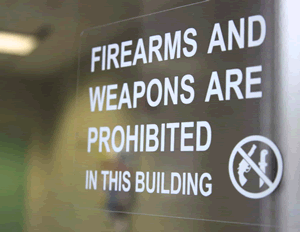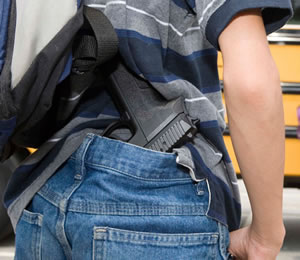Guns On Campus?
- By Michael Fickes
- 07/01/13

PHOTO © MARK RIECHERS
Gun violence on college campuses and in K–12 schools has spawned a powerful movement to allow students, faculty and staff to carry guns on campus.
In 2013, 11 states introduced legislation that would permit guns on campus. Six of those bills failed. Three remain in committee. Two states, Kansas and Texas, enacted the legislation. The Texas statute restricts guns to cars — individuals may not carry on campus.
Five more states introduced bills to allow faculty and staff to carry concealed weapons on campus. Two remain in committee. Two were defeated. One state, Arkansas, enacted the legislation, with a provision allowing colleges and universities to opt out. To date, 35 schools have opted out.
Most of the bills proposed to allow guns on campus have failed. According to the Brady Campaign to Prevent Gun Violence, since the 2007 massacre at Virginia Tech, opponents have defeated 60 proposals in 30 states.
Even so, advocates make rational arguments for allowing individuals to carry guns on campus. These are not the overheated, uninformed rants heard so often in the media. They are reasoned arguments about exercising the right to self-defense.
IN FAVOR OF GUNS ON CAMPUS
Kurt Mueller, an attorney and acting director of Public Relations for Students for Concealed Carry (www.concealedcampus.org) notes that all 50 states issue permits to carry concealed weapons, including guns.
Forty-one states have “shall issue concealed carry” laws. That means that the state must issue a permit to an individual that is of age and meets the requirements of the statute. The remaining states have “may issue” laws, meaning that satisfying the requirements of the statute isn’t necessarily enough. Maryland, for instance, requires that individuals show some kind of increased risk, such as working in an occupation that may require self-defense.
“If you get a permit from either kind of state, that means the state has determined that you can carry a gun,” says Mueller. “However, the states also place restrictions on where an individual with a permit can carry. Half of the states do not allow you to carry on campus. Half the states allow it, although carrying in a campus building is more problematic.
“If you have obtained a permit, you can carry on the street, in a theater and a grocery store. Why can’t you carry on campus? What is the distinction?
“You might argue that no one should carry a gun anywhere — that’s one thing. But if you are arguing that concealed weapons are fine except on campus, then you have to explain why a campus is different than anywhere else. We haven’t heard a satisfactory argument why college is different.”
Mueller goes on to say that individuals carry weapons for self-defense, contending that colleges and universities are not secure environments like an airport. There are no magnetometers that screen for weapons, he notes. Colleges are open environments. Anyone can walk onto a campus. Universities frequently invite the public to campus events. With tens of thousands of students, a campus has the same potential crime problems as any city.
AGAINST GUNS ON CAMPUS
 In 2008, the International Association of Campus Law Enforcement Administrators, Inc. (IACLEA) adopted a firm position against legislation that would enable students to carry weapons on campus.
In 2008, the International Association of Campus Law Enforcement Administrators, Inc. (IACLEA) adopted a firm position against legislation that would enable students to carry weapons on campus.
“In its position statement, the board in general asserted that concealed carry initiatives have the potential to increase violence on campus,” says Christopher Blake, chief staff officer with IACLEA.
The association stands by that position today. “I think our policy statement makes our arguments well,” says Anne Galvin, president of IACLEA and chief of police at California State University, Northridge. “It includes research that says there is no evidence that weapons on campus will reduce crime.
“I’ve been here for 11 years and prior to that at MIT, and I can’t think of any situation where being armed would have helped people.
“Today, violent gun tragedies occur in many places — in churches, public squares, K–12 schools and colleges. If you subtract those events, colleges and universities are safe communities.”
A U.S. Department of Justice (D.O.J.) study conducted between 1995 and 2002 compared incidents of violence against college students and non-students aged 18 to 24. The study found that students experience less violence annually than non-students. Further, nine out of 10 college students victimized by violent crime were victimized off campus.
Finally, the D.O.J. found that firearms were used in only nine percent of violent crimes against college students over the period studied.
Perhaps the strongest argument against student gun owners involves the immature impulse control of 18- to 21-year-olds combined with the prevalence of substance abuse on campus.
“Age Differences in Sensation Seeking and Impulsivity as Indexed by Behavior and Self-report,” a 2008 study funded by the John D. and Catherine T. MacArthur Foundation Research Network on Adolescent Development & Juvenile Justice, found that individuals begin to gain some control over impulsive actions at age 10.
But it takes 20 years to gain full maturity — from age 10 to age 30. College students aged 18 to 21 are only halfway through the maturation process.
Immature impulse control leads to binge drinking. In 2002, Matthew Miller, David Hemenway and Henry Wechsler published a study in the Journal of American College Health entitled “Guns and Gun Threats at College.”
That study found that two-thirds of college students that own guns engage in binge drinking. Student gun-owners are more likely than unarmed college students to drink “frequently and excessively” and then engage in risky activities, such as driving under the influence of alcohol, vandalizing property and getting into trouble with police.
300,000,000 GUNS
The population of the United States is about 314,000,000. Statistics say that there are more than 300,000,000 guns in the country, nearly one gun per person.
“If more guns made you safer, we would be the safest country on the planet,” says Debra DeShong Reed, a spokesperson for the Brady Campaign to Prevent Gun Violence. “Instead we have more gun deaths than any industrialized country.”
According to the Coalition for Gun Control, the death rate by firearms — homicides, suicides and accidents — in the United States was 10.2 per 100,000 in 2009. Ranked second among developed countries was Finland, with a rate of 4.47 per 100,000 people in 2008. In Canada, the rate was 2.5 per 100,000 people in 2009. In 2011, the rate in the United Kingdom was just 0.25 per 100,000 people.
The Brady Campaign views these kinds of statistics as arguments for reducing the number of guns available.
Recent U.S. Supreme Court decisions regarding the second amendment suggest that banning guns won’t happen in society in general. Nor will it be easy to control guns on campus.
“In District of Columbia v. Heller, the Supreme Court said that government cannot ban or restrict the use or storage of firearms in such a way as to be inconsistent with the ability to use such weapons for self-defense,” says William Alden McDaniel, Jr., an attorney experienced with constitutional issues with the Law Offices of William Alden McDaniel, Jr. “That ruling,” he says, “certainly calls into question the validity of laws that, for example, might require that guns be kept dissembled, stored in a central secure location, or kept far separate from ammunition.
“The Court recognized there can be some restrictions without delineating what they might all be,” continues McDaniel, “but at the least, Heller says that the state and federal governments cannot ban the ability to keep a working firearm of some type in one’s residence.” And because public universities “constitute extensions of the state, they are subject to the second amendment and may have to follow Heller, while (barring some state law to the contrary), private universities can ban guns if they choose to do so.”
That’s the legal underpinning. Now it’s up to the states. As state legislatures convene next year, it is likely that the nine of 11 states that proposed but failed to enact legislation to allow guns on campus will go back to work on the issue. The states that failed to enact bills allowing faculty and staff to carry will probably raise the issue again. And other states may decide to consider campus gun laws as well.
Guns on campus? Fifty states will have 50 answers.
This article originally appeared in the College Planning & Management July 2013 issue of Spaces4Learning.